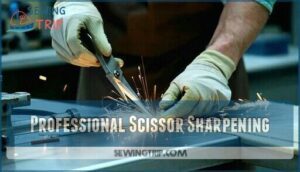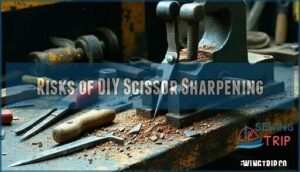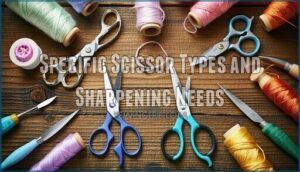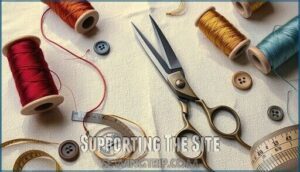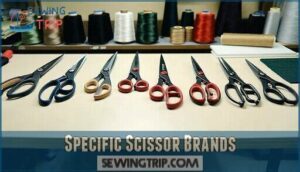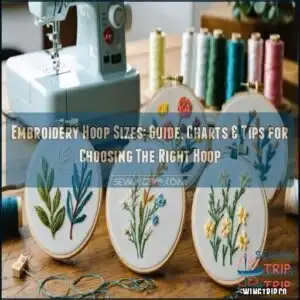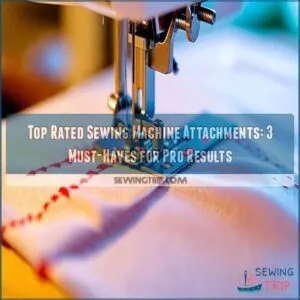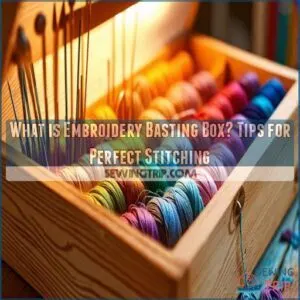This site is supported by our readers. We may earn a commission, at no cost to you, if you purchase through links.
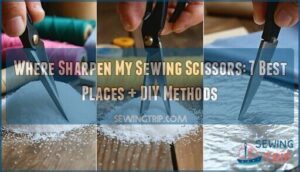 You’ve got several solid options when you’re wondering where to sharpen your sewing scissors.
You’ve got several solid options when you’re wondering where to sharpen your sewing scissors.
Local fabric stores often provide professional sharpening services, and many knife sharpeners at farmers markets handle scissors too.
Hardware stores frequently offer this service, or you can search for "knife and scissor sharpening" in your area.
For the DIY route, you can carefully cut through steel wool soap pads or fine-grit sandpaper, making sure both blades make contact.
Some crafters swear by cutting through aluminum foil several times.
Professional sharpening typically costs $5-15 but delivers superior results.
The key is choosing the right method for your specific scissor type and sharpening needs.
Table Of Contents
Key Takeaways
- You can sharpen your sewing scissors at local fabric stores, hardware stores, farmers markets, or by searching for "knife and scissor sharpening" services in your area, with professional sharpening typically costing $5-15.
- You’ll get superior results from professional sharpening services compared to DIY methods, as experts use specialized equipment to maintain proper blade angles and alignment without risking damage to your valuable scissors.
- If you choose DIY sharpening, you can cut through 150-grit sandpaper, aluminum foil, or steel wool pads, but be aware that improper techniques can permanently damage your scissors and void manufacturer warranties.
- You should sharpen your sewing scissors every 6-12 months or when you notice fabric fraying, increased cutting effort, or difficulty making clean cuts, and different scissor types like pinking shears or embroidery scissors need specialized care.
DIY Methods for Sharpening Sewing Scissors
Three simple DIY methods can restore your sewing scissors’ razor-sharp edge without leaving home.
Sandpaper Sharpening works best—fold 150-grit sandpaper with rough sides facing out, then cut through it 10-20 times using full strokes.
Aluminum Foil offers another athome sharpening solution: fold an 8-inch piece lengthwise multiple times and slice through repeatedly.
For sharpening scissors at home, try the Mason Jar technique by positioning blades around the rim and squeezing gently.
Steel Wool pads work similarly—just cut through them several times.
Even a Sewing Pin can help when squeezed between the blades.
These sharpening techniques save money and time, giving you complete control over your scissors’ performance.
Each scissor sharpening tutorial method removes nicks while realigning cutting edges effectively.
To maintain peak performance, consider regular scissor sharpening every few months.
Sharpening Other Tools
Beyond sewing scissors, your toolkit likely holds other tools that benefit from regular sharpening maintenance.
Many local sharpening services handle multiple household tools, making it convenient to restore your entire collection in one trip.
- Kitchen and Garden Tools: Knife sharpening services often sharpen garden tools, drill bits, and woodworking tools alongside your sewing scissors
- Specialized Equipment: Some scissor sharpening services near me also maintain pinking shears, rotary cutters, and craft knives using professional-grade sharpening tools
- Household Convenience: Bundling multiple tools with sewing scissors sharpening saves time and money while ensuring consistent results across your entire toolkit.
Regularly check for signs of dullness in your sewing needles.
Professional Scissor Sharpening
Professional scissor sharpening delivers precision that home methods can’t match. When your fabric scissors deserve expert care, these services restore cutting performance while preserving blade integrity.
When your scissors deserve the best, professional sharpening restores their cutting edge to factory perfection.
Here’s why professionals excel:
- Manufacturer Services: Many scissor brands offer specialized sharpening programs designed for their products.
- Mail-in Options: Convenient shipping services handle your scissors with professional care nationwide.
- Service Costs: Professional scissor sharpening typically ranges from $5-$20 per pair.
- Blade Alignment: Experts use professional tools to guarantee perfect cutting angles.
- Professional Tools: Specialized equipment maintains your fabric scissors’ original specifications.
Achieving the correct sharpening angles is vital for peak scissor performance.
Risks of DIY Scissor Sharpening
While professional services offer expertise, attempting DIY sharpening carries significant risks that could permanently damage your valuable scissors. Improper scissor sharpening techniques often result in blade misalignment and angle inconsistency, making your scissors less effective than before you started.
DIY sharpening can save money but risks damaging scissors, causing misalignment, burrs, or fractures that ruin cutting performance.
Common DIY Disasters:
- Incorrect blade angle alteration leading to edge irregularities
- Creation of burrs that snag fabric
- Formation of microscopic blade fractures
Studies show various at-home methods cause damage up to 45% of the time. Using generic tools for DIY sharpening creates damage risk because they can’t replicate professional precision. Most manufacturers void warranties when you attempt home repairs, leaving you responsible for replacement costs.
Ensuring sharp scissor blades is essential for clean cuts. Here’s what goes wrong with dull scissors fix attempts:
- Your kitchen knife sharpener grinding away too much metal
- Sandpaper creating uneven surfaces that tear delicate fabric
- Improvised tools introducing stress points that weaken blades
Ineffective sharpening often makes scissors worse than dull ones. Scissor sharpening tutorials rarely mention these consequences, but scissor sharpening safety requires understanding when professional help beats DIY methods.
Specific Scissor Types and Sharpening Needs
Different sewing scissors aren’t created equal, and each type demands specific care to maintain peak performance. Your fabric scissors need gentle handling since their precision edges can’t tolerate aggressive sharpening methods.
Embroidery Scissor Tips include using fine-grit stones to preserve delicate points, while Applique Scissor Needs focus on maintaining curved blade integrity. Pinking shears present unique challenges – their zigzag teeth require specialized angle sharpening that most DIY methods can’t achieve.
Professional services understand how to maintain each tooth’s precise geometry. Serger Shear Sharpening demands expertise since these tools cut multiple fabric layers simultaneously. Even stainless steel scissors can be sharpened at home with the right skill.
Left-Handed Scissors have reversed blade configurations that standard sharpening techniques often damage. When sharpening sewing shears at home, stick to gentle methods like fine sandpaper for basic maintenance. However, specialty shears – including vintage tailor’s scissors and surgical-grade tools – need professional attention to preserve their unique blade angles and cutting performance.
Supporting The Site
Creating valuable content about scissor sharpening services takes time and resources. You’ll find affiliate links throughout this site that help support ongoing content creation and site maintenance.
When you purchase sharpening services or tools through these links, we earn a small commission at no extra cost to you. Donations accepted through our support page help fund research into local shops, mail-in services, and testing various sharpening methods.
Your contributions allow us to visit scissor sharpening cost comparisons and review different sharpening services firsthand. Community engagement drives our mission to provide accurate, helpful information.
Reader feedback helps us identify which sharpening techniques work best and which local options deserve recommendations. Investing in quality sewing shears guarantees longevity.
Supporting independent content creators guarantees you’ll continue receiving unbiased reviews and practical advice. Every purchase and donation directly funds better scissors testing and more thorough service reviews.
Specific Scissor Brands
High-end scissor brands often provide specialized sharpening services that you can’t find elsewhere.
Many manufacturers offer lifetime warranty programs or brand-specific techniques that preserve your scissors’ original performance. These manufacturer lifetime warranty services understand your scissor’s unique steel composition and blade geometry.
One should note that stainless steel scissors can be difficult to sharpen at home.
Consider these brand sharpening services advantages:
- Brand-specific techniques guarantee proper angle maintenance for your specific model
- Scissor brand quality is preserved through factory-trained technicians
- Discontinued brand support may still be available through authorized service centers
- Fabric scissors receive specialized care designed for their intended cutting purpose
- Scissor sharpening machine calibration matches your brand’s exact specifications
Frequently Asked Questions (FAQs)
How often should sewing scissors be sharpened?
You’ll need to sharpen your sewing scissors every 6-12 months with regular use, or sooner if you notice fabric fraying, increased cutting effort, or difficulty making clean cuts through material.
What are signs my scissors need sharpening?
You’ll notice your scissors need sharpening when fabric doesn’t cut cleanly in one snip, edges look frayed or ragged.
You’re struggling with increased hand fatigue, or fabric slips and bunches while cutting, which are also signs that your scissors need sharpening.
How much does professional scissor sharpening cost?
Like finding treasure buried in your backyard, professional scissor sharpening costs between $5-$20 per pair.
You’ll discover most services charge around $10-$15, making it an affordable investment for your precious fabric shears.
Can I sharpen serrated or pinking shears?
Serrated and pinking shears can be sharpened, but they require specialized techniques and professional services.
You shouldn’t attempt DIY methods since the unique tooth patterns need expert handling to maintain their cutting effectiveness.
How do I maintain scissors between sharpenings?
Studies show properly maintained scissors stay sharp 3x longer than neglected ones.
Clean your blades after each use, store them closed in a protective sheath, and use them only on fabric to preserve their cutting edge.
Conclusion
Sharp scissors are the seamstress’s best friend, cutting through fabric like a hot knife through butter.
Whether you choose professional services or tackle it yourself, knowing where to sharpen your sewing scissors guarantees clean, precise cuts every time.
Professional sharpening delivers consistent results, while DIY methods offer quick fixes when you’re in a pinch.
Remember, well-maintained scissors last longer and make your sewing projects more enjoyable, and your fabric will thank you for keeping those blades razor-sharp.

